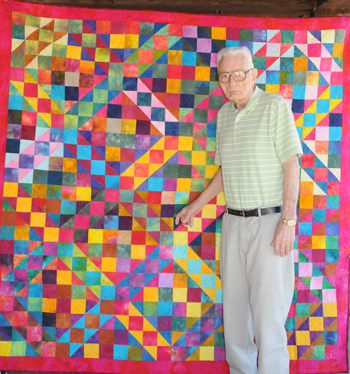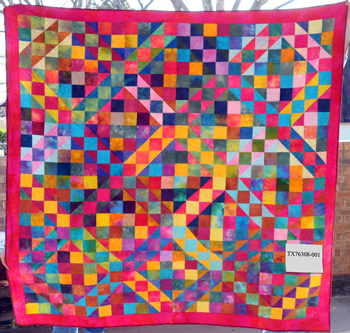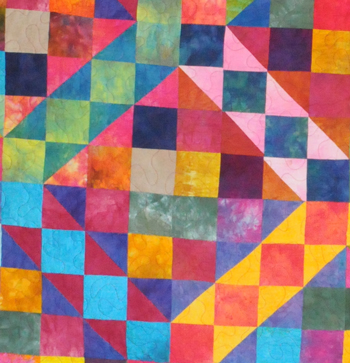
 [The interviewee, Richard Tims, is joined on the call by his son Ricky Tims. Ricky occasionally speaks to Richard and Meg to help clarify questions and answers.]
[The interviewee, Richard Tims, is joined on the call by his son Ricky Tims. Ricky occasionally speaks to Richard and Meg to help clarify questions and answers.]
Meg Cox (MC): Today’s date is March 21, 2010 and it’s 12:13 pm and I’m conducting an interview with Richard Tims for the Quilters’ S.O.S. – Save Our Stories project. Richard is in Wichita Falls, Texas and I’m in Princeton, New Jersey, we’re speaking by phone and–uh Skype actually, to conduct this interview. And thank you so much for doing this today. Richard, I’ve got a picture of this quilt that–can you tell me about this quilt that you’re using as your quilt for this interview?
Ricky Tims (RT2) Let me explain that. [to Richard.] Dad, the quilts that you’ve been making, all of these quilts like that you’ve been making–
Richard Tims (RT1): Yeah.
RT2: She has a picture of one of those quilts.
RT1: Okay.
RT2: And she wants you to tell her about that quilt.
RT1: I’ll try.
RT2: Okay. Tell her what you know about it.
MC: So tell me about the quilt.
RT1: Well, I don’t know, I just—uh, picked it up one day and made this little block and then I made another little block kind of went with it. I just kind of fell in with it. I’ve made–uh, several quilts out of it.
MC: Does this pattern have a name?
RT1: No, I haven’t named it [laughs.].
RT2: I would chime in to say that we officially call it “Papaw’s Choice.”
MC: Right.
RT2: Because it’s just squares and half square triangles, but we did publish that on TheQuiltShow.com under the title “Papaw’s choice,” but that was my name giving it to him.
MC: Okay.
RT2: I think it’s also loosely based on jewel box?
RT1: Yeah.
RT2: Yeah.
MC: Okay. What do you think, somebody looking at this quilt, what might they conclude about you? What does this quilt tell people about you do you think?
RT2 [to Richard.]: What do you think people can learn from looking at that quilt about you?
RT1: I don’t know. I never give that much of a thought. It just–I don’t know. [laughs.]
RT2 [to Richard.]: What about the colors you use? Sorry, Meg.
MC: It’s okay
RT1: Oh, I just use any color that comes along and I don’t know that either. I just, just slap it together sometimes. Maybe it look good, if it don’t–don’t suit me, I’ll pull it out and do something else.
MC: Okay, what age were you when you started making quilts?
RT1: Well, I was gonna say 65.
MC: Okay. Why did you start?
RT1: Why did I start? Well, I was working with the trucking company and I was working four days on, and four days off and I didn’t have nothing to do around the house but nothing, and I says if Mama can make a quilt at 85, Richard surely you can make one at 65 [MC laughs.], and I started in. And I worked four days off in here by myself and then I’d go back and work my four days and come back work another four on the quilts. Something to play with, pass time away, and it just kept getting bigger and bigger and bigger. [MC laughs.]
MC: So do you make quilts now that you’re not working? Do you make quilts every day? What is your quilting schedule like?
RT1: Oh, I’ve got a little room out in the back of the house, attached to the house with air-conditioning and everything. I have to go outside to get into it, but I just keep my sewing machine out there and if I feel like going out and sewing I’ll go out and sew a hour, two hours, and come back in and–they, I don’t get no hurry about anything, just kinda go out there and make me four or five blocks maybe and come back in the house and sit down. Television gets bad, I’ll go back out and make another one. [MC laughs.]
MC: How many people in your family quilt? I know your son quilts.
RT1: I guess my mother was the only one I know of that, uh quilts, quilted. But, uh I kinda copied after her a little bit. And then uh Ricky he come in and he started quilting with us.
MC: Are people surprised when you tell them that you’re a quilt maker?
RT1: Mmm, well no.
MC: What are your favorite techniques?
RT1: Oh I don’t know I got one that I made myself but I haven’t got no name for it. It’s just… I wouldn’t know what else to start naming it.
RT2 [to Richard.]: She’s wanting to know what your favorite techniques are—what, how—do you like to hand sew, do you like the sewing machine, do you like rotary cutter, what do you like to do?
RT1: Oh, I like my sewing machine.
MC: Okay, so you do everything on the machine?
RT1: Everything on the sewing machine, yeah.
MC: Alright okay, and–
RT2 [to Richard.]: You use a rotary cutter.
RT1: I use a rotary cutter such as that, but I do my sewing on my sewing machine.
RT2: Meg, I have I got a question about chiming in. Do you want me to not chime in or–because I know there’s an answer to that question, but he might not know quite how to articulate it.
MC: Well if you have a follow up question you think might help get him to a more thorough answer I would say–
RT2: Okay, I just particularly know that dad, uh he likes to layer fabrics together and draw his squares and diagonals and does the stitching on that so that he can do sort of quick, quick assembly half square triangles and he’s very good at doing that, but it it’s kind of hard to describe that that’s what he does a lot.
MC: Well let me ask you this, Richard, see, the quilt that you brought here has beautiful fabric and it doesn’t have patterns on it, it’s more of a uh, sort of a solid and it might be hand dyed. Where do you get your fabric and do you ever use–is that a fairly typical look to your quilt?
RT1: Well, I get Ricky’s scraps.
MC: [laughs.]
RT1: That’s where I get–that’s where I make most of my–I don’t–I can’t remember ever purchasing anything to make this quilt, but I just get Ricky’s scraps and go from there.
MC: And beautiful scraps they are.
RT1: Yes, they are.
MC: Very beautiful. Let me ask you this, um, do have you ever used quilting to get through a difficult time. In other words, have you had a rough time where it was sort of a therapeutic thing for you or is it just fun?
RT1: Is it just what?
RT2 [to Richard.]: Is it just fun?
RT1: It’s just fun, I just go out there and pass time away and come back in the house and watch television awhile and it gets where I don’t like it I go back out and make another block or two.
MC: Now what are your plans for your quilts? When you make a quilt are you making it for yourself, are you thinking I’m making this for this specific person? Talk about where your quilts go.
RT1: Oh I don’t have any regular plan for them if I’ve got one made and somebody comes round and likes it and I can give it to ’em. Give it to Ricky, give it to my daughter, granddaughters, my great granddaughters.
RT2 [to Richard.]: Sometimes you make the quilt for somebody though.
RT1: Yeah, sometimes yeah.
RT2 [to Richard.]: Sometimes, for like for I wanted to make that for Brian and you made it in fabrics that Brian would like. Sometimes–
RT1: Yeah sometimes, yeah.
RT2: But not very often—yeah.
MC: What were your mother’s quilts like?
RT1: Oh, I don’t know, uh–
RT2: Stars, lone stars–
RT1: No, she didn’t make lone star–broken star? Broken star maybe. I don’t know, just square blocks most of it I think. Just–
MC: Now I understand you made a quilt with Ricky that had a lone star in it, didn’t it – am I right?
RT1: Yeah, uh huh.
MC: Was that a lot of work? What was that like?
RT1: Oh it’s just–I don’t make work out of it, I just twiddle with it every once in awhile and if I don’t like it I’ll pitch it out and try to see if I can make another one.
MC: What do you think makes a great quilt?
RT1: What do I think makes a great quilt?
RT2 [to Richard.]: What makes a great quilt? Successful quilt?
RT1: I don’t know much about that. I just don’t have that in mind when I’m working on them. I just–if I like that block I’ll make it, if I don’t like it, well I’ll throw it in the trash. [MC laughs.]
MC: In terms of, um, other quilts made by other people are there particular quilts that you’re drawn to or particular quiltmakers that that you, that you feel are really something special?
RT1d: No, I just try–I just pretty well stay on the same pattern all the time.
MC: Do you ever go to a museum or um a place to see a quilt show to see other people’s work?
RT1: I go follow– go with Ricky’s quite a bit whenever he’s having them on show.
MC: Has his work inspired you in some way?
RT1: Well it helped a lot.
MC: What’d you say?
RT1: What he’s doing, but, uh I can’t say he’s the one who told me to start.
MC: Right. So that was your own idea?
RT1: Yeah.
MC: Why is quiltmaking important to your life, Richard?
RT1: Just something for me to be a-doing. Pass the time away.
MC: Do you, um–how do you have your quilts that you–do you keep some of your quilts and where are they, are they hanging on the wall, are they on the beds? What do they mean to you at home?
RT1: Oh, I don’t know, I got some on the bed, and I got some give to kids and grandkids and I’ve got–
RT2: Got one on the wall
RT1: Got one on the wall over there, a little, little quilt. there’s one on the wall.
MC: So you have one on the wall in your kitchen? Or is that where you are?
RT1: Got in a living area.
MC: I see, okay. You’re um, pointing towards the wall and on Skype I can see you’re sort of in a kitchen area.
RT1: Yeah.
MC: So you’re at what, a dining room table?
RT1: That’s the kitchen. To my right is my living room–the den or whatever you want to call it.
MC: Oh I see it, over there it’s on the wall, um by some chairs and the television over there so you have that quilt where you can see it.
RT1: Uh, huh.
MC: When you’re in your living room. Terrific. Um, do you have any idea how many quilts you have made so far?
RT1: No, I have no idea how to start telling you how much, how many.
MC: You think it’s more than 10?
RT1: Yes, quite a few more.
MC: Okay. Do you have uh, some goals for your quiltmaking going forward? It sounds like it’s um it’s sort of something you do to occupy yourself that gives you pleasure and you don’t have a quota, but how do you think about it?
RT1: Well I don’t know, I just I just make it so it’s just something to be a doing, pass the time away.
MC: Right.
RT1: And I may go out and I may quilt 30 minutes and I may go out and I might quilt an hour, two hours at a time, I’m just I just kind of roll with the flow. I don’t get in a hurry with it.
MC: You go with the flow? Is that what you said?
RT1: Yeah.
MC: That’s a good way to be. What–do you want your quilts to be preserved, do you think that they will last and be remembered by your family members?
RT1: I kind of think they will be, yes.
MC: Have you ever given them to somebody who’s not in your family?
RT1: Yes.
MC: And who was that?
RT1: I don’t know, don’t remember but who they are, but I have gave some quilts away to different ones.
MC: Do you name your quilts, or not?
RT1: Do what?
MC: Give them a name?
RT1: No, I never name one.
MC: Do you put a label on them so people know that have a record that it was made by you?
RT1: Yes, yes.
MC: Now what about finishing your quilts, do you do that or the quilting part or–
RT1: I just I just do the quilting top and then I’ll take it down to a quilt show and let them–a quilt show, a quilt shop and let them make it—quilt it up for me.
MC: Okay. Do you think that quilts are important to American life? Do you that that’s the thing now to be quilting?
RT2: Ask that one more time please, Meg.
MC: Yeah. Do you think that quilts are important in American life?
RT1: Oh, I think so, yes.
MC: Yes, you do. Okay. Is there, um anything else you want to say about your quilting and uh how you want to be remembered?
RT1: Oh, I don’t know, I’m not much of a–uh, on telling things like that. Don’t know much about that. No, I just kinda roll with the flow.
MC: Okay, alright, well I think that um–that’s a good place to end. I want to thank Richard Tims for allowing me to interview him today as part of the Quilters’ S.O.S.-Save Our Stories project and our interview concluded at12:29 pm March 21, 2010. Thank you so much.
RT1: Okay.
MC: Thank you.
RT1: Thank you.

